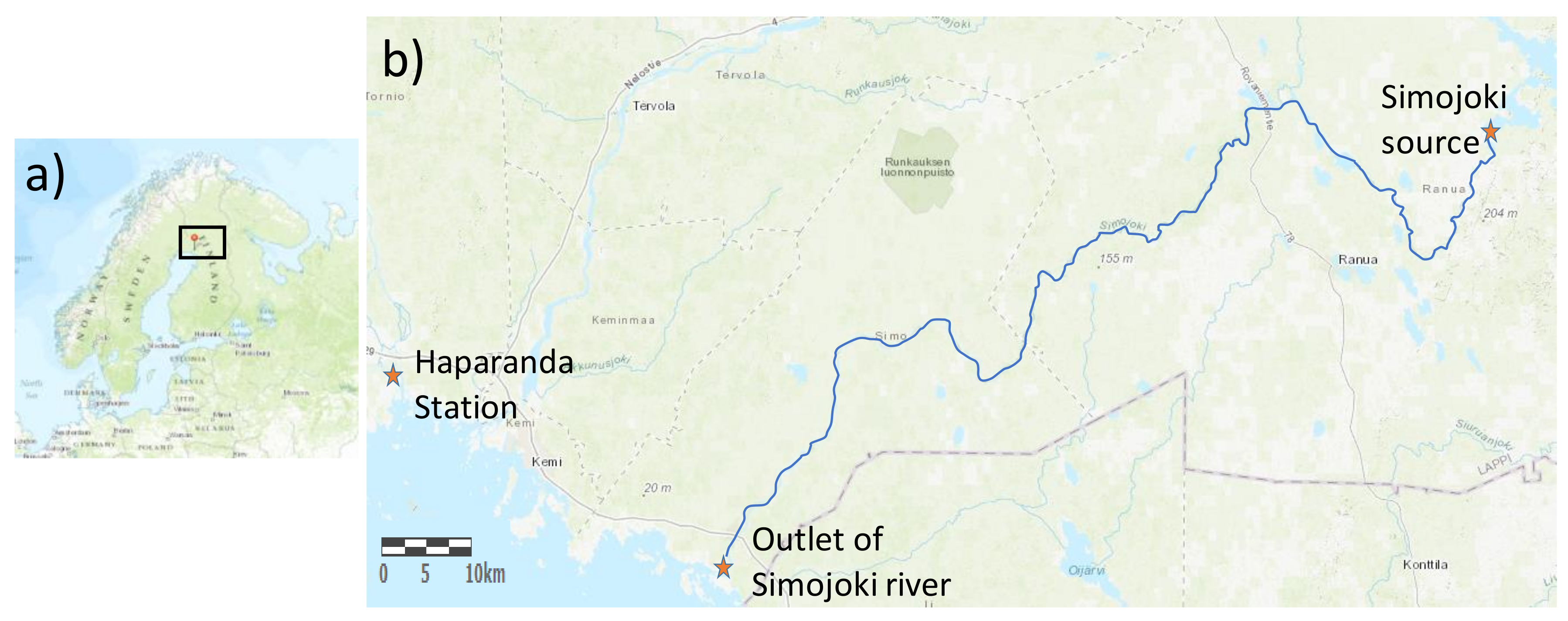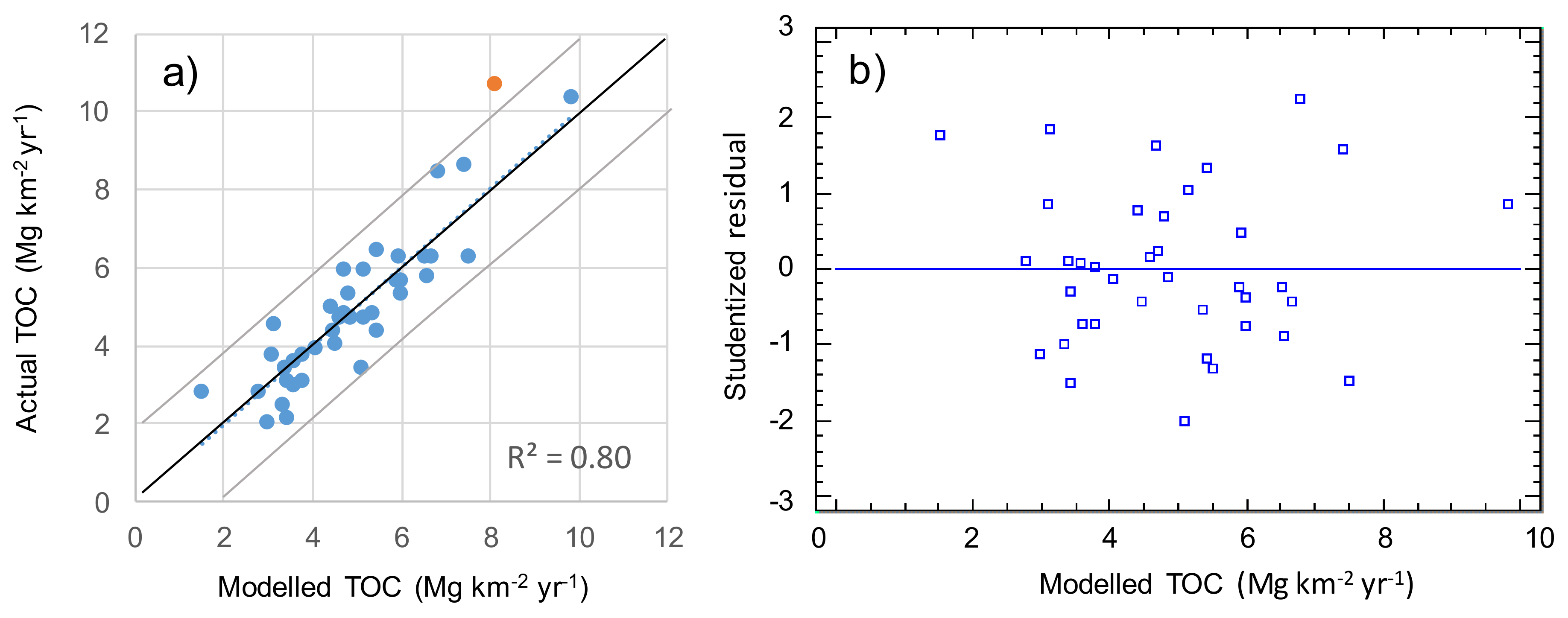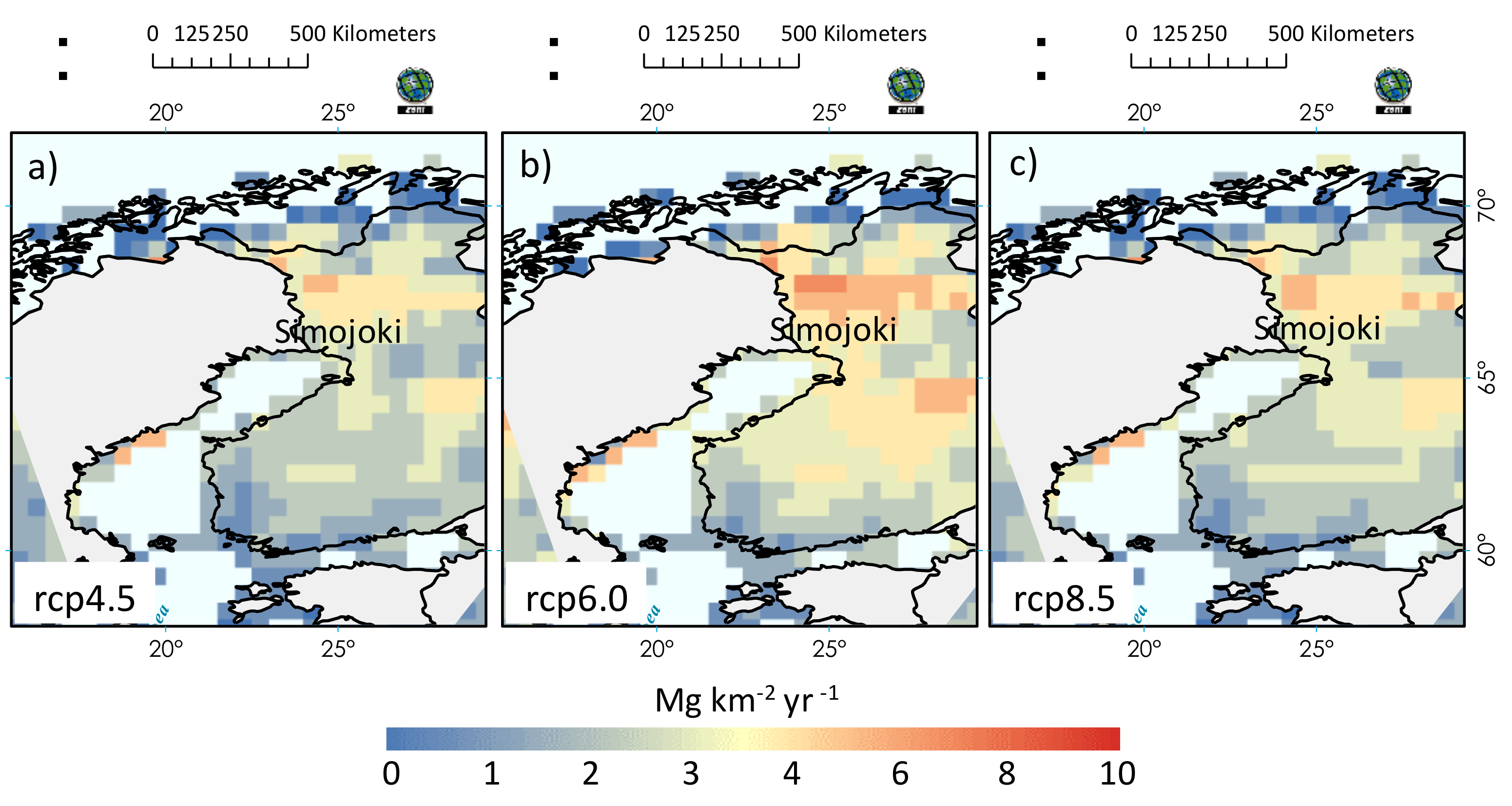A First Regional-Scale Estimate of Climate-Driven Terrestrial Carbon Export in Boreal Catchments
Abstract
:1. Introduction
2. Materials and Methods
2.1. Study Area and Data Sources
2.2. Modelling Approach
3. Results and Discussion
3.1. Parameterization and Evaluation
3.2. Reconstruction and Analysis of Historical Changes in Carbon Export
3.3. Spatial Pattern of TOC
4. Conclusions
Acknowledgments
Author Contributions
Conflicts of Interest
References
- Huotari, J.; Nykänen, H.; Forsius, M.; Arvola, L. Effect of catchment characteristics on aquatic carbon export from a boreal catchment and its importance in regional carbon cycling. Glob. Chang. Biol. 2013, 19, 3607–3620. [Google Scholar] [CrossRef] [PubMed]
- Forster, P.; Ramaswamy, V.; Artaxo, P.; Berntsen, T.; Betts, R.; Fahey, D.W.; Haywood, J.; Lean, J.; Lowe, D.C.; Myhre, G.; et al. Changes in atmospheric constituents and in radiative forcing. In Climate Change 2007 Physical Science Basis. Contribution of the Work Group I to the Fourth Assessment Report of the Intergovernmental Panel on Climate Change; Solomon, S., Qin, D., Manning, M., Chen, Z., Marquis, M., Averyt, K.B., Tignor, M., Miller, H.L., Eds.; Cambridge University Press: Cambridge, UK, 2007. [Google Scholar]
- Bastviken, D.; Tranvik, L.J.; Downing, J.A.; Crill, P.M.; Enrich-Prast, A. Freshwater methane emissions offset the continental carbon sink. Science 2011, 331, 50. [Google Scholar] [CrossRef] [PubMed]
- Buffam, I.; Turner, M.G.; Desai, A.R.; Hanson, P.C.; Rusak, J.A.; Lottig, N.R.; Stanley, E.H.; Carpenter, S.R. Integrating aquatic and terrestrial components to construct a complete carbon budget for a north temperate lake district. Glob. Chang. Biol. 2011, 17, 1193–1211. [Google Scholar] [CrossRef]
- Striegl, R.G.; Dornblaser, M.M.; McDonald, C.P.; Rover, J.R.; Stets, E.G. Carbon dioxide and methane emissions from the Yukon River system. Glob. Biogeochem. Cycles 2012, 26, GB0E05. [Google Scholar] [CrossRef]
- Schelker, J.; Eklöf, K.; Bishop, K.; Laudon, H. Effects of forestry operations on dissolved organic carbon concentrations and export in boreal first-order streams. J. Geophys. Res. 2012, 117, G01011. [Google Scholar] [CrossRef]
- Minkkinen, K.; Korhonen, R.; Savolainen, I.; Laine, J. Carbon balance and radiative forcing of Finnish peatlands 1900–2100—The impact of forestry drainage. Glob. Chang. Biol. 2002, 8, 785–799. [Google Scholar] [CrossRef]
- Vuorenmaa, J.; Forsius, M. Recovery of acidified Finnish lakes: Trends, patterns and dependence of catchment characteristics. Hydrol. Earth Syst. Sci. Discuss. 2007, 4, 3249–3283. [Google Scholar] [CrossRef]
- Dikau, R.; Herget, J.; Hennrich, K. Land use and climate impacts on fluvial systems during the period of agriculture in the River Rhine catchment (RhineLUCIFS)—An introduction. Erdkunde 2005, 59, 177–183. [Google Scholar] [CrossRef]
- Diodato, N.; Bellocchi, G. Climate-scale modelling of rainstorm-induced organic carbon losses in land-soil of Thune Alpine areas, Switzerland. In Storminess and Environmental Change; Diodato, N., Bellocchi, G., Eds.; Springer: Dordrecht, The Netherlands, 2014; pp. 205–214. [Google Scholar]
- Wasson, R.J. Land Use and Climate Impact on Fluvial Systems during the Period of Agriculture; PAGES Workshop Report Series 96-2; World Data Center-A for Paleoclimatology: Boulder, CO, USA, 1996; pp. 1–51. [Google Scholar]
- Hahnwald, S. Historical Land Use in Scandinavia and Its Influence on Carbon Storage in Soil and Peat in the Boreal Landscape. Ph.D. Thesis, Umeå University, Umeå, Sweden, 2016. [Google Scholar]
- Meyer-Jacob, C.; Tolu, J.; Bigler, C.; Yang, H.; Bindler, R. Early land use and centennial scale changes in lake-water organic carbon prior to contemporary monitoring. Proc. Natl. Acad. Sci. USA 2015, 112, 6579–6584. [Google Scholar] [CrossRef] [PubMed]
- Matskovsky, V.V.; Helama, S. Testing long-term summer temperature reconstruction based on maximum density chronologies obtained by reanalysis of tree-ring data sets from northernmost Sweden and Finland. Clim. Past 2014, 10, 1473–1487. [Google Scholar] [CrossRef] [Green Version]
- Meyer-Jacob, C.; Vogel, H.; Boxberg, F.; Rosén, P.; Weber, M.E.; Bindler, R. Independent measurement of biogenic silica in sediments by FTIR spectroscopy and PLS regression. J. Paleolimnol. 2014, 52, 245–255. [Google Scholar] [CrossRef]
- Bragée, P.; Mazier, F.; Rosén, P.; Fredh, D.; Broström, A.; Granéli, W.; Hammarlund, D. Forcing mechanisms behind variations in total organic carbon (TOC) concentration of lake waters during the past eight centuries—Palaeolimnological evidence from southern Sweden. Biogeosci. Discuss. 2013, 10, 19969–20003. [Google Scholar] [CrossRef] [Green Version]
- Freeman, C.; Evans, C.D.; Monteith, D.T.; Reynolds, B.; Fenner, N. Export of organic carbon from peat soils. Nature 2001, 412, 785. [Google Scholar] [CrossRef] [PubMed]
- Hongve, D.; Riise, G.; Kristiansen, J. Increased colour and organic acid concentrations in Norwegian forest lakes and drinking water—A result of increased precipitation? Aquat. Sci. 2004, 66, 231–238. [Google Scholar] [CrossRef]
- Sarkkola, S.; Koivusalo, H.; Laurén, A.; Kortelainen, P.; Mattsson, T.; Palviainen, M.; Piirainen, S.; Starr, M.; Finér, L. Trends in hydrometeorological conditions and stream water organic carbon in boreal forested catchments. Sci. Total Environ. 2009, 408, 92–101. [Google Scholar] [CrossRef] [PubMed]
- Sobek, S.; Tranvik, L.J.; Prairie, Y.T.; Kortelainen, P.; Cole, J.J. Patterns and regulation of dissolved organic carbon: An analysis of widely distributed lakes. Limnol. Oceanogr. 2007, 52, 1208–1219. [Google Scholar] [CrossRef]
- Carvalhais, N.; Forkel, M.; Khomik, M.; Bellarby, J.; Jung, M.; Migliavacca, M.; Mu, M.; Saatchi, S.; Santoro, M.; Thurner, M.; et al. Global covariation of carbon turnover times with climate in terrestrial ecosystems. Nature 2014, 514, 213–217. [Google Scholar] [CrossRef] [PubMed]
- Schmidt, M.W.I.; Torn, M.S.; Abiven, S.; Dittmar, T.; Guggenberger, G.; Janssens, I.A.; Kleber, M.; Kögel-Knabner, I.; Lehmann, J.; Manning, D.A.C.; et al. Persistence of soil organic matter as an ecosystem property. Nature 2011, 478, 49–56. [Google Scholar] [CrossRef] [PubMed]
- Walling, D.E.; Fang, D. Recent trends in the suspended sediment loads of the world’s rivers. Glob. Planet. Chang. 2003, 39, 111–126. [Google Scholar] [CrossRef]
- Williamson, C.E.; Dodds, W.; Kratz, T.K.; Palmer, M.A. Lakes and streams as sentinels of environmental change in terrestrial and atmospheric processes. Front. Ecol. Environ. 2008, 6, 247–254. [Google Scholar] [CrossRef]
- Adrian, R.; O’Reilly, C.M.; Zagarese, H.; Baines, S.B.; Hessen, D.; Keller, W.; Livingstone, D.M.; Sommaruga, R.; Straile, D.; Van Donk, E.; et al. Lakes as sentinels of current climate change. Limnol. Oceanogr. 2009, 54, 2283–2297. [Google Scholar] [CrossRef] [PubMed] [Green Version]
- Anderson, N.J.; Bindler, R.; Engstrom, D.R.; Jones, J.; Leavitt, P.R. Organic carbon sequestration by Arctic lakes: Comparing across regions to identify rates and controls. In Proceedings of the THAW 2014—THermokarst Aquatic Ecosystems Workshop, Quebec City, QC, Canada, 12–15 March 2014. [Google Scholar]
- Schefuß, E.; Eglinton, T.I.; Spencer-Jones, C.L.; Rullkötter, J.; De Pol-Holz, R.H.; Talbot, M.; Grootes, P.M.; Schneider, R.R. Hydrologic control of carbon cycling and aged carbon discharge in the Congo River basin. Nat. Geosci. 2016, 9, 687–690. [Google Scholar] [CrossRef]
- Wohl, E.; Dwire, K.; Sutfin, N.; Polvi, L.; Bazan, R. Mechanisms of carbon storage in mountainous headwater rivers. Nat. Commun. 2012, 3, 1263. [Google Scholar] [CrossRef] [PubMed]
- Galy, V.; Peucker-Ehrenbrink, B.; Eglinton, T. Global carbon export from the terrestrial biosphere controlled by erosion. Nature 2015, 521, 204–207. [Google Scholar] [CrossRef] [PubMed]
- Milly, P.C.D. A minimalist probabilistic description of root zone soil water. Water Resour. Res. 2001, 37, 457–463. [Google Scholar] [CrossRef]
- Lepistö, A.; Granlund, K.; Rankinen, K. Integrated nitrogen modeling in a boreal forestry dominated river basin: N fluxes and retention in lakes and peatlands. Water Air Soil Pollut. 2004, 4, 113–123. [Google Scholar] [CrossRef]
- Perkkiö, S.; Huttula, E.; Nenonen, M. Water Protection Plan for the Simojoki River Basin; Publication of the Water and Environment Administration—Series A; Helsinki University Press: Helsinki, Finland, 1995. [Google Scholar]
- Kortelainen, P. Content of total organic carbon in Finnish lakes and its relationship to catchment characteristics. Can. J. Fish. Aquat. Sci. 1993, 50, 1477–1483. [Google Scholar] [CrossRef]
- Diodato, N.; Støren, E.W.N.; Bellocchi, G.; Nesje, A. Modelling sediment load in a glacial meltwater stream in western Norway. J. Hydrol. 2013, 486, 343–350. [Google Scholar] [CrossRef]
- Buishand, T.A. Some methods for testing homogeneity of rainfall records. J. Hydrol. 1982, 58, 11–27. [Google Scholar] [CrossRef]
- Kokfelt, U.; Rosen, P.; Schoning, K.; Christensen, T.R.; Förster, J.; Karlsson, J.; Reuss, N.; Rundgren, M.; Caallaghan, T.V.; Jonasson, C.; et al. Ecosystem responses to increased precipitation and permafrost decay in subarctic Sweden inferred from peat and lake sediments. Glob. Chang. Biol. 2009, 15, 1652–1663. [Google Scholar] [CrossRef]
- Köhler, S.J.; Buffam, I.; Laudon, H.; Bishop, K.H. Climate’s control of intra-annual and interannual variability of total organic carbon concentration and flux in two contrasting boreal landscape. J. Geophys. Res. 2008, 113, G03012. [Google Scholar] [CrossRef]
- De Wit, H.A.; Austnes, K.; Hylen, G.; Dalsgaard, L. A carbon balance of Norway: Terrestrial and aquatic carbon fluxes. Biogeochemistry 2015, 123, 147–173. [Google Scholar] [CrossRef]
- Räike, A.; Mattson, T.; Kortelainen, P.; Thomas, D.N. Long-term trends (1975–2014) in the concentrations and export of carbon from Finnish rivers to the Baltic Sea: Organic and inorganic components compared. Aquat. Sci. 2016, 78, 505–523. [Google Scholar] [CrossRef]
- Larsen, S.; Andersen, T.; Hessen, D.O. Climate change predicted to cause severe increase of organic carbon in lakes. Glob. Chang. Biol. 2011, 17, 1186–1192. [Google Scholar] [CrossRef]
- Dwarakish, G.S.; Ganasri, B.P. Impact of land use change on hydrological systems: A review of current modeling approaches. Cogent Geosci. 2015, 1, 1115691. [Google Scholar] [CrossRef]





© 2018 by the authors. Licensee MDPI, Basel, Switzerland. This article is an open access article distributed under the terms and conditions of the Creative Commons Attribution (CC BY) license (http://creativecommons.org/licenses/by/4.0/).
Share and Cite
Diodato, N.; Esposito, L.; Bellocchi, G. A First Regional-Scale Estimate of Climate-Driven Terrestrial Carbon Export in Boreal Catchments. Climate 2018, 6, 22. https://doi.org/10.3390/cli6020022
Diodato N, Esposito L, Bellocchi G. A First Regional-Scale Estimate of Climate-Driven Terrestrial Carbon Export in Boreal Catchments. Climate. 2018; 6(2):22. https://doi.org/10.3390/cli6020022
Chicago/Turabian StyleDiodato, Nazzareno, Libera Esposito, and Gianni Bellocchi. 2018. "A First Regional-Scale Estimate of Climate-Driven Terrestrial Carbon Export in Boreal Catchments" Climate 6, no. 2: 22. https://doi.org/10.3390/cli6020022




